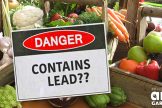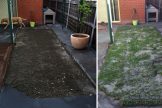
With so many different types of fertilisers out there, it’s hard to know which one is the best to use. Here’s a bit of a background info on the
different types of fertiliser available and how they affect your garden.
Certified Organic
Certified organic fertilisers need to be tested by a certifying body (NASAA or BFA) to be an allowable input for certified organic products. The ingredients in a Certified Organic fertiliser are analysed to ensure they do not contain any heavy metal contamination, are sourced though sustainable techniques and are GMO free… among a range of other input specific requirements. Commonly used ingredients in these types of fertilisers are chicken manures, composts, seaweeds and animal by-products.
A typical N-P-K (Nitrogen-Phosphorus-Potassium) rating for a Certified Organic allowed input fertiliser is 4:3:2.
Organic or organic based
The term ‘organic’ generally refers to products that contain a majority of ingredients from an organic source such as chicken manure or animal by-products such as bone meal. As the term ‘organic’ is not regulated, the organic content and quality of the fertilisers is extremely variable. Depending on the brand they may be very good, very bad or somewhere in between.
A typical N-P-K for an Organic fertiliser is 6:3:10.
Some of the specialist fertilisers are organic based but have added trace elements that are specifically required by the type of plant that you need to feed. The advantage of this combination is that they will act as a complete fertiliser but have less of an impact on the environment than an entirely synthetic fertiliser.
Organic fertilisers are made from animal manures, compost and products of plant and animal matter, such as seaweed, or blood and bone meal. Animal manures alone vary greatly in their nutrient content. Added to compost, all animal manures produce the best and safest all-purpose fertiliser, containing both major and minor elements.
Use of composted manures eliminates smells and provides five times the nutrition as fresh manures. As a fertiliser, organic manures have many advantages.
- They are a permanently-renewable resource and require less energy for their manufacture than chemical fertilisers. This also means they are cheaper.
- By adding humus to the soil, they feed beneficial soil micro-organisms and build good soil structure, in contrast to soluble chemical fertilisers which do not contribute to soil health at all.
- They do not damage important soil microflora, such as earthworms.
- They do not contain heavy metal residues, such as cadmium, which have been found in ingredients of some artificial fertilisers.
- It is very difficult to overdose plants with organic manures.
- They recycle important nutrients and organic matter back into the soil, helping to preserve the health of soils, which are one of our most important natural resources.
There are many improvers which can be added to your soil to revitalise it and make it rich and nutritious for your plants. Of course, your own well made compost is invaluable in feeding your soil and encouraging worms and essential microbes to visit. Below are some organic based fertilisers.
Pelletised Organic Fertilisers
These are organic general fertilisers based on chicken manure, and sometimes containing fish meal, seaweed and blood and bone. It is suitable for every feeding situation and application encountered by the home gardener. It is easy to use, non burning and impurity free. It slowly releases nutrients into the soil as it breaks down. This category includes products like Dynamic Lifter and Grow Better organic fertiliser.
Organic Blood and Bone
High nitrogen and phosphorus content. Breaks down gradually and adds nitrogen to the soil. A favourite with organic gardeners. These contain much higher amounts of Nitrogen than manures. Blood supplies very high quantities of Nitrogen, whilst bone supplies high amounts of Phosphorous. Because blood is broken down fast by soil bacteria, the release of Nitrogen is rapid. This is a fast-acting, strong fertiliser.
Seaweed based fertilisers
These include products such as Maxicrop, Seasol, Amgrow seaweed plant tonic, and Fair Dinkum Fertiliser liquid seaweed. Excellent as a root stimulant when planting out seedlings and as a general tonic for established plants.
These products may also contain various trace elements and componants of soil microflora and as such often increase the ability for plant roots absorb water and nutrients. They are excellent used as when transplanting seedlings and larger plants, or as a tonic for more established plants. Spray it over young leaves e.g. roses, to harden them up and make them less susceptible to insect attack.
Fish Emulsion
Organic liquid fertiliser made from fish. Charlie Carp is made from European Carp fished out of inland waters where the carp wreak havoc with the native ecosystem. At last there is a good use for this menace! Amgrow fishfert is another fish emulsion. These boost the health of plants with organic Nitrogen, Phosphorous and Potassium (N,P,K). They are a good source of N and P especially. They are easy to use, however they don’t contribute to the structure of soils.
Nitrosol
Organic liquid fertiliser for all container grown plants.
Mushroom Compost
Available in bulk from Bulleen Art & Garden – excellent as a soil conditioner or as a mulch. Not recommended
around acid-loving plants, such as camellias, daphnes, rhododendrons and azaleas. Excellent for use in the
vegetable garden.
Comfrey
Plants available from Bulleen Art & Garden herb section. Excellent source of potassium. Use wilted leaves under grass clippings as a mulch around tomato bushes and bush fruits. It also makes an excellent compost activator.
Straws
The use of straws, spent pea straw or lucerne hay as mulching material will greatly benefit any garden, particularly if they are supplemented with some well rotted animal manure. A mulch of this type will provide good soil insulation, a supply of plant nutrients, free circulation of air and rapid absorption of moisture, and a supply of humus. All of these can be purchased at Bulleen Art and Garden in bales or compressed in bags.
Dolomite
Although not strictly a fertiliser, dolomite lime acts to neutralize acid soils. It differs from garden lime in that it contains magnesium. Add it in small quantities to smelly compost heaps to “sweeten” the acid content or sprinkle over a vegetable garden well before planting to provide a slightly alkaline pH suitable for your plants. This is a naturally-occurring mineral compound of calcium and magnesium carbonate. It provides essential magnesium and calcium to the soil. Note: It is important to get soil tested first to make the correct choice of soil additive.
Gypsum
Again, gypsum is not a fertiliser but is commonly used to break up clay soils. It is almost neutral in pH so it won’t alter the existing soil. It acts to bind together the very fine clay particles to resemble a crumbly soil like structure, making it easier for plants to take root in. It is naturally-occurring Calcium sulfate. After the addition of gypsum, we recommend adding compost, which provides organic matter to the soil, aiding formation of good structure and feeding the microflora in the soil. Note: A critical amount of gypsum is required to amend soil. For very heavy soils, 1 Kg per square metre may be required.
Poultry Manures
These are available pure or mixed with dry litter material. The pure form provides maximum nutrients to plants. Poultry manure mixed with litter is a good source of humus for the soil. Poultry manures have strong nutritional value with a high Nitrogen content. They also contain trace elements, such as Copper and Zinc. Poultry manures tend to be the strongest of the manures, and as such are ideally added to soil several weeks before planting. If top dressing with poultry manure, spread in a very thin layer over the soil and water in well. Fresh poultry litter is excellent mixed in compost.
Cow, Sheep, Horse & Goat Manures
These are the safest, gentlest fertilisers, lower in Nitrogen than poultry manures. Use on seedlings. Dig a generous amount into the top 10 cm of soil. These will not burn young plants. Great for vegetable seedlings!
Synthetic
These types of fertilisers provide plants with a very specific and targeted range of nutrients. Their formulas are normally designed for a specific purpose. Lawn starters and orchid flower promoting fertilisers are examples. The response from a synthetic fertiliser by the plants is quicker than organic fertilisers as the nutrients are in a readily available form. These types of fertilisers can burn plants if used incorrectly, they don’t improve the soil, can damage the environment through their manufacture and, if allowed to wash into our rivers, can result in toxic algal blooms and the nutrification of our waterways.
There is a great amount of variability in the N-P-K of synthetic fertilisers, a soluble all purpose may be 27:6:9 whereas a lawn starter is generally closer to 10:1.25:5.
Two other products that you may want to read more about are Zeolite and Hyrdrocell. Zeolite is a naturally occurring mineral with a highly porous atomic structure and a negative charge allowing it to attract and hold water soluble cations including ammonium, potassium, magnesium and calcium. Unlike gels which expand as they absorb water and contract as they release it, Hydrocell has a stable cell structure. This means when it is not storing water it is storing air which provides improved soil aeration to the roots of the plants. Hydrocell is biodegradable lasting up to 10 years in the soil. Click here to read more about Zeolite and Hydrocell.
So… which one do I use?
We recommend only using totally synthetic fertilisers when it is absolutely necessary. In the great majority of situations a totally organic or organic based fertiliser can supply plants with all of the nutrients that they require. You also get the added bonuses of improving your soil and using a product with less
of an environmental impact.





